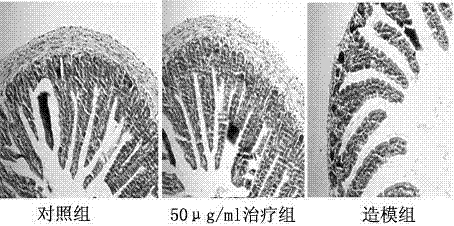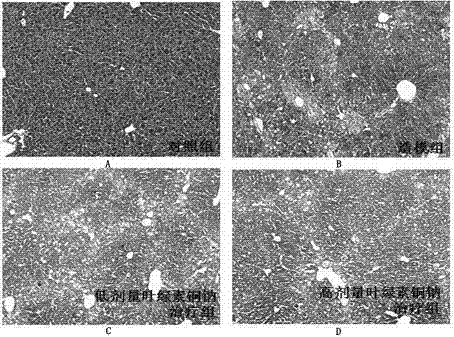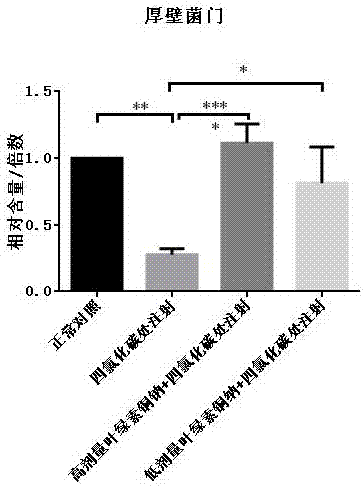The use of sodium copper chlorophyllin
A technology of sodium copper chlorophyllin and bacteria, which is applied in the field of medicine to achieve the effect of alleviating liver disease and increasing the number of bacteria
- Summary
- Abstract
- Description
- Claims
- Application Information
AI Technical Summary
Problems solved by technology
Method used
Image
Examples
Embodiment 1
[0039] Example 1: sodium copper chlorophyllin protects the small intestinal chorion
[0040] 1. Materials and methods
[0041] 1.1 Materials
[0042] Male C57BL / 6 and BALB / C mice were provided by Beijing Huafukang Biotechnology Co., Ltd.; chlorophyllin sodium copper powder was provided by Chengdu Tongde Pharmaceutical Co., Ltd., and the molecular formula is C 34 h 29 CuN 4 Na 3 o 6 , molecular weight: 722.13, CAS number: 65963-40-8; carbon tetrachloride (CCl 4 ) and mineral oil were provided by sigma; methionine choline deficiency (MCD) feed was provided by Nantong Trofee Feed Technology Co., Ltd.
[0043] 1.2 Reagent preparation
[0044] Sodium copper chlorophyllin agent (mother solution): Add 50 ml of sterilized ultrapure water and 100 mg of sodium copper chlorophyllin powder into a 50 ml sterilized centrifuge tube in turn in an ultra-clean workbench, vortex to mix and store at 4°C.
[0045] CCl 4 Injection: 0.75 ml, 2.25 ml, 3.75 ml of CCl were respectively mixed ...
Embodiment 2
[0056] Example 2: Oral administration of sodium copper chlorophyllin can effectively prevent liver fibrosis / cirrhosis
[0057] 1.1 Materials
[0058] Male BALB / C mice were provided by Beijing Huafukang Biotechnology Co., Ltd.; sodium copper chlorophyllin powder was provided by Chengdu Tongde Pharmaceutical Co., Ltd., and the molecular formula is C 34 h 29 CuN 4 Na 3 o 6 , molecular weight: 722.13, CAS number: 65963-40-8; carbon tetrachloride (CCl 4 ) and mineral oil are provided by sigma;
[0059] 1.2 Reagent preparation
[0060] Sodium copper chlorophyllin agent (mother solution): Add 50 ml of sterilized ultrapure water and 100 mg of sodium copper chlorophyllin powder into a 50 ml sterilized centrifuge tube in turn in an ultra-clean workbench, vortex to mix and store at 4°C.
[0061] CCl 4 Injection: 0.75 ml, 2.25 ml, 3.75 ml of CCl were respectively mixed in the ultra-clean workbench 4 and 14.25ml, 12.75ml, 11.25ml of mineral oil were added to a 15ml sterilized ce...
Embodiment 3
[0068] Example 3: Sodium copper chlorophyllin up-regulates Firmicutes bacteria in the intestinal tract of animals with liver cirrhosis
[0069] image 3 Shown are the results of relative quantification of fecal bacteria in mice. Compared with normal healthy mice, the relative content of Firmicutes bacteria in the feces of mice with liver cirrhosis induced by carbon tetrachloride injection was significantly reduced, and the bacteria of Firmicutes in mice treated with sodium copper chlorophyllin returned to normal levels . As Gram-positive cells, Firmicutes are the most dominant commensal bacteria in the gut. It is generally believed that Firmicutes decompose undigested food in the small intestine in the intestine, produce short-chain fatty acids, and obtain energy absorption. We found that long-term injection of carbon tetrachloride caused liver cirrhosis, and we found that the process of liver cirrhosis was related to the decline of intestinal Firmicutes bacteria. A large ...
PUM
 Login to View More
Login to View More Abstract
Description
Claims
Application Information
 Login to View More
Login to View More - R&D
- Intellectual Property
- Life Sciences
- Materials
- Tech Scout
- Unparalleled Data Quality
- Higher Quality Content
- 60% Fewer Hallucinations
Browse by: Latest US Patents, China's latest patents, Technical Efficacy Thesaurus, Application Domain, Technology Topic, Popular Technical Reports.
© 2025 PatSnap. All rights reserved.Legal|Privacy policy|Modern Slavery Act Transparency Statement|Sitemap|About US| Contact US: help@patsnap.com



